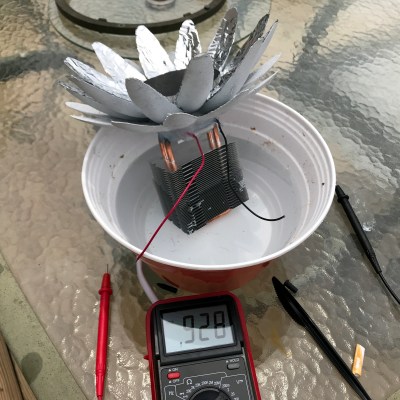A great place to get your feet wet with the data-network-wonderland that is modern-day automobiles is the Car Hacking Village at DEF CON. I stopped by on Saturday afternoon to see what it was all about and the place was packed. From Ducati motorcycles to junkyard instrument clusters, and from mobility scooters to autonomous RC test tracks, this feels like one of the most interactive villages in the whole con.
Lily Power Pods Make The Seebeck Effect Look Good

The Seebeck effect (part of the broader thermoelectric effect) is how a difference in temperature can be directly converted into a voltage, and it is the operating principle behind things like thermocouples and Peltier junctions. Harnessing this effect in an effort to wrangle a useful electrical current out of the environment has led to some interesting ideas, like the Lily Power Pods by [Josh Starnes].
What’s interesting about this particular design is that the artistic angle crosses over with functionality. Electrically speaking, the pods have one side of the thermoelectric generator heated by the sun while the other is cooled by being submerged in water, and the temperature differential creates a measurable voltage. [Josh] designed the pods to resemble flowers, with foil petals that help direct sunlight towards the blackened “hot side” of the thermoelectric generator while water takes care of the cool side.
Are foil petals the best way to gather and direct sunlight? They are not, but the idea is to have the pods look like something other than the floating hunks of machinery that they are. Since the pods must float in water and be exposed to sunlight, they will as a result have high visibility. [Josh] seems to feel that it’s important that they not be an eyesore. After all, a less efficient generator that doesn’t overstay its welcome still generates more power than one that has figuratively been handed its hat and told to move along.
Electrostatically Accelerated Ping-Pong Ball Travels The Circuit
There is a special breed of hardware hacker whose playground lies in the high voltage arena. Their bench sizzles with the ozone and plasma of Tesla coils, and perhaps it’s best not to approach it without a handy fluorescent light tube to sniff for unseen hazards. There are many amazing things that can come of these experiments, and fortunately for those of us who lack the means or courage to experiment with them there are many YouTube videos to satisfy our curiosity.
One such comes from [Plasma channel], in the form of a table-top ping-pong ball accelerator. It lacks impressive sparks but makes up for it in scientific edification, because it uses static electricity to send a conductive-paint-coated ping-pong ball spinning round the inside of a curved glass bowl. It does this using alternate positive and negatively charged strips of aluminium tape on the inside of the bowl, each of which charges the ball as it rolls over it, then giving it a bit of repulsive force to keep it spinning. His power comes from a couple of small Wimshurst machines, but no doubt other similar generators could be used instead.
The whole is an entertaining if a little hazardous talking point, and a fun weekend build. The parts are easy enough to find that you might even have them to hand. If continued electrostatic diversion floats your boat, you might like to read our recent excursion into the subject.
Continue reading “Electrostatically Accelerated Ping-Pong Ball Travels The Circuit”
Teardown: Queercon 15 Badge (and The Game Hidden Within)
Queercon is a conference within a conference. Taking place within DEF CON, Queercon is a social network of LGBT hackers that gathers each year to host events, talks, and a kickin’ pool party. Since 2012 they have also been building electronic badges as part of the fun and I can vouch that they’re contenders for most creative badge design every single year.
A total of 450 electronic badges were made this year, and the aesthetic is as close to a polished consumer product as I have ever seen in a badge, yet they also retain the charm and feel of unique electronics built for hardware geeks. With wireless communication that delivers a complex and clever game to the badges, the designers are encouraging interaction between people (not just between badges). I had the chance to do a teardown of one of these glorious badges, and also gathered quite a bit of info on the puzzles within during Friday’s badge talk in the QC suite.
Join me after the break as I tear down the Queercon 15 hardware badge. If you haven’t yet looked over my review of the official DC26 badge, check that out as well!
Continue reading “Teardown: Queercon 15 Badge (and The Game Hidden Within)”
Updating A 1999 Saab With An Arduino
Unless your car is fresh off the lot, you’ve probably had the experience of riding in a newer car and seeing some feature or function that triggered a little pang of jealousy. It probably wasn’t enough for you to run out and sign yourself up for a new car loan (which is what the manufacturer was hoping for), but it was definitely something you wished your older model vehicle had. But why get jealous when you can get even?
 [Saabman] wished his 1999 Saab 9-5 had the feature where a quick tap of the turn signal lever would trigger three blinks of the indicator. Realizing this was an electronic issue, he came up with a way to retrofit this function into his Saab by adding an Arduino Pro Micro to the vehicle’s DICE module.
[Saabman] wished his 1999 Saab 9-5 had the feature where a quick tap of the turn signal lever would trigger three blinks of the indicator. Realizing this was an electronic issue, he came up with a way to retrofit this function into his Saab by adding an Arduino Pro Micro to the vehicle’s DICE module.
The DICE (which stands for Dashboard Integrated Central Electronics) module controls many of the accessories in the vehicle, such as the lighting and wipers. In the case of the blinkers, it reads the state of the signal lever switches and turns the blinkers on and off as necessary. After poking around the DICE board, [Saabman] found that the 74HC151 multiplexer chip he was after: the state of the blinker switches could be read from pins 1 and 2, and he’d even be able to pull 5 V for the Arduino off of pin 16.
After prototyping the circuit on a breadboard, [Saabman] attached the Pro Micro to the top of the 74HC151 with some double sided tape and got to work on refining the software side of the project. The Arduino reads the state of the turn signal switches, and if they flick on momentarily it changes the pin from an input to an output and brings it high for three seconds. This makes the DICE module believe the driver is holding the turn lever, and will keep the blinkers going. A very elegant and unobtrusive way of solving the problem.
Hackers aren’t complete strangers to the garage; from printing hard to find parts to grafting in their favorite features from other car manufacturers, this slick Saab modification is in good company.
The Quick-Build PowerWall
Elon Musk isn’t just the greatest human being — he’s also a great inventor. He’s invented the reusable rocket, the electric car, and so much more. While those are fantastic achievements, Elon’s greatest invention is probably the PowerWall. The idea of a PowerWall is simple and has been around for years: just get a bunch of batteries and build a giant UPS for your house. Elon brought it to the forefront, though, and DIYers around the world are building their own. Thanks, Elon.
Of course, while the idea of building your own PowerWall is simple, the devil is in the details. How are you going to buy all those batteries? How are you going to connect them together? How do you connect it to your fuse box? It’s a systems integration nightmare, made even more difficult by the fact that lithium cells can catch fire if you do something wrong. [jehugarcia] is building his own PowerWall, and he might have hit upon an interesting solution. He’s built a modular system to store and charge hundreds of 18650 cells. It looks great, and this might be the answer to anyone wanting to build their own PowerWall.
Aside from acquiring hundreds of 18650 cells, the biggest problem in building a PowerWall is simply connecting all the cells together. This can be done with 3D printed battery holders, solder, and bus bars, with a few people experimenting with spot welding wires directly onto the cells. This project might be a better solution: it uses standard plastic battery holders easily acquired from your favorite Chinese retailer and a PCB to turn cells into a battery.
The design of this battery module consists of a PCB with sufficiently wide traces, an XT60 power connector, and a few headers for the balance connector of a charger. This is a seven cell setup, and in contrast to the hundreds of hours that go into making a PowerWall the old fashioned way, these modules can be assembled pretty quickly.
Testing of these modules revealed no explosions, and everything worked as intended. There was a problem, though: when drawing a high load, the terminals of these cheap battery connectors got up to 150°. That makes these modules unsuitable for high load applications like an e-bike, but it should be okay if you’re putting hundreds of these modules together to power your house. It might be a good idea to invest in some cooling, though.
Continue reading “The Quick-Build PowerWall”
Line Following Robot Without The Lines
Line-following robots are a great intro to robotics in general, since the materials and skills needed to build a good one aren’t too advanced. It turns out that line-following robots are more than just a learning tool, too. They’re pretty useful in industry, but most of them don’t follow visible marked lines. Some, like this inductive guided robot from [Randall] make use of wires to determine their paths.
Some of the benefits of inductive guidance over physical lines are that the wires can be hidden in floors, so if something like an automated forklift is using them at a warehouse there will be less trip hazard and less maintenance of the guides. They also support multiple paths, so no complicated track switching has to take place. [Randall]’s robot is a small demonstration of a larger system he built as a technician for an autonomous guided vehicle system. His video goes into the details of how they work, more of their advantages and disadvantages, and a few other things.
While inductive guided robots have been used for decades now, they’re starting to be replaced by robots with local positioning systems and computer vision. We’ve recently seen robots that are built to utilize these forms of navigation as well.




















